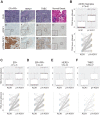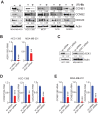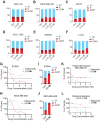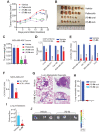Epigenetic reprogramming of cell cycle genes by ACK1 promotes breast cancer resistance to CDK4/6 inhibitor
- PMID: 37330596
- PMCID: PMC10348910
- DOI: 10.1038/s41388-023-02747-x
Epigenetic reprogramming of cell cycle genes by ACK1 promotes breast cancer resistance to CDK4/6 inhibitor
Abstract
Hormone receptor-positive, HER2-negative advanced breast cancers exhibit high sensitivity to CDK4/6 inhibitors such as palbociclib. However, most patients inevitably develop resistance, thus identification of new actionable therapeutic targets to overcome the recurrent disease is an urgent need. Immunohistochemical studies of tissue microarray revealed increased activation of non-receptor tyrosine kinase, ACK1 (also known as TNK2) in most of the breast cancer subtypes, independent of their hormone receptor status. Chromatin immunoprecipitation studies demonstrated that the nuclear target of activated ACK1, pY88-H4 epigenetic marks, were deposited at cell cycle genes, CCNB1, CCNB2 and CDC20, which in turn initiated their efficient transcription. Pharmacological inhibition of ACK1 using its inhibitor, (R)-9b dampened CCNB1, CCNB2 and CDC20 expression, caused G2/M arrest, culminating in regression of palbociclib-resistant breast tumor growth. Further, (R)-9b suppressed expression of CXCR4 receptor, which resulted in significant impairment of metastasis of breast cancer cells to lung. Overall, our pre-clinical data identifies activated ACK1 as an oncogene that epigenetically controls the cell cycle genes governing the G2/M transition in breast cancer cells. ACK1 inhibitor, (R)-9b could be a novel therapeutic option for the breast cancer patients that have developed resistance to CDK4/6 inhibitors.
© 2023. The Author(s).
Conflict of interest statement
A patent “Inhibitors of ACK1/TNK2 Tyrosine Kinase” (patent no. 9,850,216; 10,017,478 and 10,336,734) covers (
Figures







Similar articles
-
ACK1 tyrosine kinase interacts with histone demethylase KDM3A to regulate the mammary tumor oncogene HOXA1.J Biol Chem. 2014 Oct 10;289(41):28179-91. doi: 10.1074/jbc.M114.584425. Epub 2014 Aug 22. J Biol Chem. 2014. PMID: 25148682 Free PMC article.
-
Targeting PEG10 as a novel therapeutic approach to overcome CDK4/6 inhibitor resistance in breast cancer.J Exp Clin Cancer Res. 2023 Nov 28;42(1):325. doi: 10.1186/s13046-023-02903-x. J Exp Clin Cancer Res. 2023. PMID: 38017459 Free PMC article.
-
Resistance to cyclin-dependent kinase (CDK) 4/6 inhibitors confers cross-resistance to other CDK inhibitors but not to chemotherapeutic agents in breast cancer cells.Breast Cancer. 2021 Jan;28(1):206-215. doi: 10.1007/s12282-020-01150-8. Epub 2020 Aug 28. Breast Cancer. 2021. PMID: 32860163 Free PMC article.
-
ACK1 tyrosine kinase: targeted inhibition to block cancer cell proliferation.Cancer Lett. 2013 Sep 28;338(2):185-92. doi: 10.1016/j.canlet.2013.04.004. Epub 2013 Apr 15. Cancer Lett. 2013. PMID: 23597703 Free PMC article. Review.
-
ACK1/TNK2 tyrosine kinase: molecular signaling and evolving role in cancers.Oncogene. 2015 Aug 6;34(32):4162-7. doi: 10.1038/onc.2014.350. Epub 2014 Oct 27. Oncogene. 2015. PMID: 25347744 Free PMC article. Review.
Cited by
-
Non-Receptor Tyrosine Kinases: Their Structure and Mechanistic Role in Tumor Progression and Resistance.Cancers (Basel). 2024 Aug 2;16(15):2754. doi: 10.3390/cancers16152754. Cancers (Basel). 2024. PMID: 39123481 Free PMC article. Review.
-
Role of the circular RNAs/microRNA/messenger RNA axis in renal cell carcinoma: From gene regulation to metabolism and immunity.iScience. 2025 Mar 11;28(4):112183. doi: 10.1016/j.isci.2025.112183. eCollection 2025 Apr 18. iScience. 2025. PMID: 40212586 Free PMC article. Review.
-
Targeting CDK4/6 in breast cancer.Exp Mol Med. 2025 Feb;57(2):312-322. doi: 10.1038/s12276-025-01395-3. Epub 2025 Feb 10. Exp Mol Med. 2025. PMID: 39930131 Free PMC article. Review.
-
Advancements in Dalpiciclib for the Treatment of Breast Cancer Patients: A Review.Breast Cancer (Dove Med Press). 2025 Jun 30;17:557-565. doi: 10.2147/BCTT.S529794. eCollection 2025. Breast Cancer (Dove Med Press). 2025. PMID: 40620909 Free PMC article. Review.
-
Prostate cancer immunotherapy: Improving clinical outcomes with a multi-pronged approach.Cell Rep Med. 2023 Oct 17;4(10):101199. doi: 10.1016/j.xcrm.2023.101199. Epub 2023 Sep 21. Cell Rep Med. 2023. PMID: 37738978 Free PMC article. Review.
References
-
- Sung H, Ferlay J, Siegel RL, Laversanne M, Soerjomataram I, Jemal A, et al. Global cancer statistics 2020: GLOBOCAN estimates of incidence and mortality worldwide for 36 cancers in 185 countries. CA Cancer J Clin. 2021;71:209–49. - PubMed
-
- Zhao W, Zhang Q, Kang X, Jin S, Lou C. AIB1 is required for the acquisition of epithelial growth factor receptor-mediated tamoxifen resistance in breast cancer cells. Biochem Biophys Res Commun. 2009;380:699–704. - PubMed
-
- Nass N, Kalinski T. Tamoxifen resistance: from cell culture experiments towards novel biomarkers. Pathol Res Pr. 2015;211:189–97. - PubMed
MeSH terms
Substances
Grants and funding
LinkOut - more resources
Full Text Sources
Medical
Molecular Biology Databases
Research Materials
Miscellaneous

